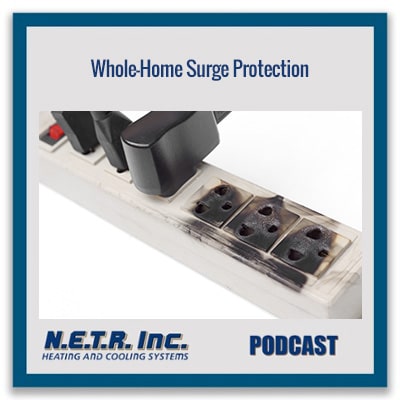
Brett Rogenski talks with John Maher about whole-home surge protection. He outlines the different types of surge protectors, and then, he explains why a whole-home surge protector is a great investment for homeowners.
John Maher: Hi, I am John Maher. I’m here today with Brett Rogenski, General Manager of N.E.T.R., Inc, a heating and cooling company in Massachusetts with a focus on Mitsubishi ductless heating and cooling products. Today we’re talking about whole-home surge protection. Welcome Brett.
Brett Rogenski: Hey John, thank you so much for having me.
What Draws Electricity in Your Home?
John: Sure. So Brett, in addition to upgrades to electrical panels and converting to ductless mini splits for your heating and your air conditioning, and maybe even replacing your gas stoves and dryers, what are some other things in the home that draw power that maybe we don’t think about all the time?
Brett: Well, you know what, in this modern era, so much of what we use in our home is electric, okay? And also those electronics have become more sensitive over time because they’re not driven off switches, they’re driven off of little micro boards.
So things that we don’t think about necessarily in our home, obviously we’ve got our fridges, and our freezers, and our heat pumps, and ACs and all this different stuff. All of your televisions, all your nice LED TVs, those are all electronic. Obviously anything our tablets that are plugged in and being charged, et cetera. Any sort of music systems that are in there as well. So lighting obviously is all there, but there’s a lot of stuff that we either have plugged in all the time or we plug it in intermittently, so think of your iPad being charged, that we rely on electricity and clean electricity for in our home.
The Importance of Whole-Home Surge Protection
John: So why does installing a whole-home surge protection system make sense, especially as we move toward a whole-home electrification plan?
Brett: Sure. So I think of it as two things. The first one is, because more and more things are driven off of microprocessors, off of little computer boards, they’re much more sensitive than some sort of robust electric switch that was run in Mom’s dryer in 1971. So the electronics have become more sophisticated and more fragile. They’re more susceptible to power surges.
John: Right. You used to be able to get away with it. If you had a little surge, your lights would flicker a little bit and then everything would just come back on and it would be fine. But these days, all those little electronic devices could just get fried by a big surge.
Brett: Exactly. Literally everything has an electronic board in it, from your toaster to your refrigerator, to your iPad, to your TV, all of them, literally everything. And they’re much more subject to damage from surges. So that’s the first thing I think of, is that things are much more susceptible at this point.
And then the second thing that I think of when I think about surge protection is the fact that our grid is perhaps a little less stable than it used to be as well. So we have more issues, brownouts and that sort of thing than we did in the past. Especially in New England where we have a fairly aged electrical grid. So certainly we don’t have some of the problems that maybe California has, but we do have brownouts. We do have a lot of older infrastructure there, which then leads to power conditioning issues coming into the house. So leading to those surges up and down in power.
Types of Surge Protection Devices
John: Right. So are there different types of surge protection devices and how are they installed in a home?
Brett: Sure. So pretty much two flavors. One is kind of an end-point-of-use surge protector. So we’ve all seen the power strips that say, “Hey, I’m a surge protector too.” And those are good. Those are better than not having a surge protector, but they only protect what is plugged into them, and they’re much more limited in terms of their level of protection.
The next option, which is really the preferred option, is whole-home surge protection. A whole-home surge protector is a much more robust device, which is attached actually to your electrical panel. And it protects every device in your home that is tied to that electrical panel, which is ultimately everything.
So instead of a strip that you plugged your computer into, that is protecting only your computer, this whole home surge protection device is protecting everything that is tied to your home’s electrical panel from your mini split, to your refrigerator, to your iPad plugged in the wall being charged, and everything else in between. Your washer, your dryer, your refrigerator, all of it.
John: Now, you might still need power strips to take your one outlet and make it into six so you can power all your, like you said, your TV and your gaming system or something like that. But does it eliminate the need to have individual surge protectors on each one of those devices?
Brett: Completely eliminates that need. So everything, essentially that conditioning of that power if you will, that surge protection is happening at the panel before the electricity is distributed out into the household.
How Whole-Home Surge Protectors Work
John: And does it also condition, like you said, the electricity, so you’re just getting a more even level of electricity and you don’t have those little dips, again with the old light bulbs, they would sometimes flicker and dim when there was a slight little change in the electrical current. Does it help to eliminate those as well?
Brett: It doesn’t really help to eliminate those dips, but it protects those surges.
John: Okay.
Brett: And the surges are what then essentially overload those little circuit boards and stuff. The dips aren’t so damaging, they’re annoying, but those surges are what can just absolutely ‘cook’ your piece of electronics. And so yeah, they’re designed to eliminate those and they’re self-sacrificing.
What happens is when there is a power surge, whether that be from maybe… It can be from a lot of things, it can come from the street, so power recovery after an outage, a ground fault, an overload internally of a circuit or faulty wiring, all of those things can cause it. And what they do is the surge protector actually absorbs that excess voltage and essentially self sacrifices slowly over time to ensure that that excess voltage does not pass through to those devices in your home. Other sources can be even lightning hits and that sort of thing as well.
How Long Do Whole-Home Surge Protectors Last?
John: So do you have to replace the whole-home surge protection system or part of it occasionally in order to make sure that you’re fully protected?
Brett: Well, most people will probably go a lifetime without having to protect it because there’s a degree of degradation that’s built in. So it’s kind of meant to consume itself a little bit over time. But you absolutely can’t… Number one, if you have a lot of small frequent things, it’ll chip away at that over time. Or if you have one big event. Again, your home gets struck in a direct hit by lightning, that’s going to most likely destroy that surge protector in the process of it protecting you.
And the nice part about modern surge protectors, whole-home surge protectors is two things. They usually have, at least the ones that we have, N.E.T.R. uses a very high quality one that we work directly with a manufacturer for. It has an indicator LED that is showing that it’s working, and it also has a little sounder in it so that if that surge protector has now failed because it absorbed a giant power strike or was chipped away at over time, number one, that LED goes from green to red.
And then number two, there’s a little sounder in there that makes a little buzzing noise, a little squeaking noise, kind of like your, I don’t know, maybe like your smoke detector to tell you to come down and take a look at it. And then that does require replacement at that point.
The whole-home surge protectors that we use, number one, come with a lifetime warranty for residential homeowners. So if you had a situation like that, we’re going to replace that thing for you at no cost. So not only did it do its job, we’re going to come replace it at no cost. But in addition, the manufacturer, and we register you for this when you have us put one in, the manufacturer provides a $100,000 insurance policy towards your home’s electronics as well. So if that surge protector failed and you did lose… I don’t know whatever, your televisions due to a surge, they are going to invoke that insurance policy to reimburse you for that.
John: That’s great.
Brett: ever had to pay one out here, but it’s there for you for peace of mind.
Incentives for Installing Whole-Home Surge Protectors
John: Nice to know that it’s there right? Are there any incentives for installing a whole-home surge protection device, any tax incentives or rebates or anything like that to help lessen the cost?
Brett: Unfortunately there’s not, but the good news is whole-home surge protectors are not wildly expensive. A very high quality whole-home surge protector like we use at NE.T.R., depending on your exact situation, we’re talking a few hundred dollars and we’re not talking thousands of dollars. So a few hundred dollars.
And if you think about it, think of everything that plugs into a wall, either all the time or occasionally in your home, and its value. Your heat pump, your refrigerator, your washing machine, your dryer, I could go down the list, you’ve got your iPad plugged in, you’ve got your gaming system. You literally probably have tens of thousands of dollars of electronics being plugged in at any given moment that are vulnerable without that whole-home surge protector.
So it’s really a very small investment that gives you tremendous peace of mind. And then on top of it all, it’s backed up by that warranty as well as that insurance policy in the tremendously unlikely event that it failed you.
Surge Protectors Are a Great Investment for Homeowners
John: Any other final tips or recommendations for people that are considering installing a whole-home surge protection system?
Brett: Yeah, two things is that, number one, I think it’s one of the best investments a homeowner can make. More and more electronics are expensive and we’re more reliant upon them. And then number two is that it helps you avoid that catastrophic outage.
So we would rather you put in a whole-home surge protector and protect that investment, that $10, $20, $30,000 heat pump system that you’re now heating and cooling your home with. We’d much rather you spend a few dollars and protect that than not, and we’re out there replacing it and you’re having to deal with an insurance company. So it’s really just tremendous peace of mind and they’re extremely effective.
John: All right, well that’s really great information. Great advice, Brett. Thanks again for speaking with me today.
Brett: Thanks so much John.
John: And for more information, you can visit the N.E.T.R. website at netrinc.com or call 781 933 NETR. That’s 781 933 6387.

